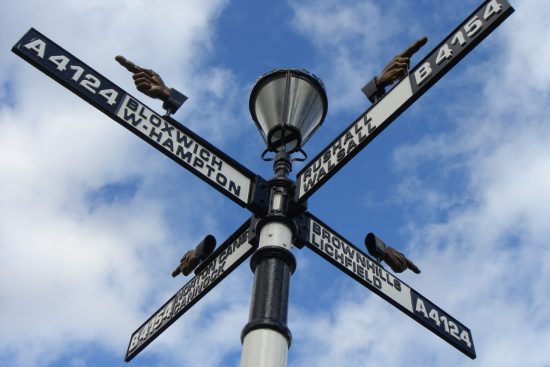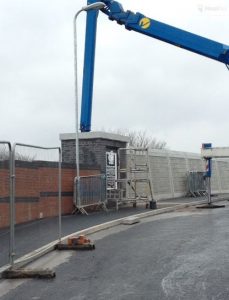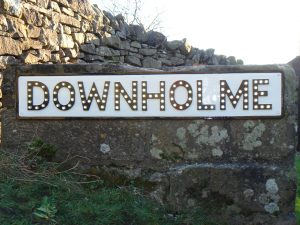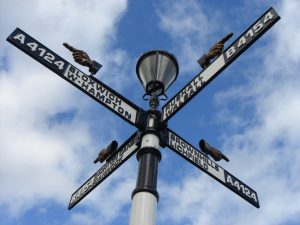The observant among us will have noticed that Beresford Road Bridge is open again. The eagle-eyed will have also spied some lovingly restored original signs adorning the bridge. This week Inskplott caught up with David Gosling of Signpost Restoration, the business behind the project.
Inksplott: Hi David Gosling, thank you for being interviewed for Inksplott. Can you tell us a little about yourself and your business, Signpost Restoration?
David: Signpost Restoration was born when my wife, a parish councillor at the time, volunteered me to restore an old and battered fingerpost in our village. This was a Cumberland County Council post at Lanercost in north east Cumbria dating from the early 1900’s.
The resulting restoration was so well received that I was soon asked to undertake further restorations on fingerposts in neighbouring parishes. Cumbria has hundreds of traditional cast iron fingerposts and the business grew as a result of the reputation gained through these early projects and the resulting publicity – not least the Sunday Telegraph Motoring Supplement in 2003.
Up until 2006 I ran the business remotely as I continued to manage shopping centres in County Durham and Bologna. Then I devoted myself full time to the business and now carry out projects throughout England and Wales (only one in Scotland so far).
Up to date we have restored fingerposts, mileposts, milestones, village nameplates, railway bridge plates, railway platform columns, historic crests and village water pumps.
Inksplott: And how come you came to restore the Beresford Road Bridge signs?
David: Only two of the original four Beresford Road Bridge plates remained and when contractors Bam Nuttall decided that the remaining two were important pieces of local history they carried out an internet search for a restorer capable of handling such work. They found www.signpost-restoration.co.uk and we were instructed to restore the two 109 year-old commemorative plates.
Inksplott: What’s your speciality?
David: Restoration of historic metal structures and our ability to manufacture/repair the missing/broken components necessary to complete an outstanding restoration.
We even make brand new fingerposts exactly like an original from the early 1900’s would have looked. This is popular where villages or towns have a modern signpost in a prominent position within the town/village and seek to replace it with a replica of the long lost original.
Research into typefaces used and design details is an important part in producing a true restoration
Inksplott: What’s your best story since setting up the business?
David: There are many but the ones that remain in my memory are the village nameplates restored for Downholme, near Richmond, in North Yorkshire and the much loved ‘fingerpost’ in Pelsall restored for Walsall Borough Council.
The Downholme project was to restore two existing plates and manufacture a new one to replace a third plate which had been stolen. These plates were cast in aluminium and carried ‘cats eyes’ reflectors set into the cast lettering to provide illumination for on-coming traffic at night. There were only 9 of the aluminium letters restorable out of the 27 required and of the 102 cats eyes remaining, 312 were needed in total, none had retained the important reflective paint.
Making the lettering was enough of a challenge but to find suitable reflectors was something else.
Contacting the ‘Reflective Roadstud Company’ of Halifax provided the solution as they were the company founded by Percy Shaw the famous inventor of the ‘cats eye’ reflectors. Remarkably they found the 312 needed in the warehouse and when they arrived wrapped in copies of the 1953 Yorkshire Post I new that I had the original items. A picture is attached.
The Pelsall fingerpost is reputed to be on the site of England’s first ever fingerpost, a wooden post now in a museum somewhere, and is much loved by the people of Pelsall. What makes this post unique is that it was constructed from whatever materials where available at the time. So it has a post from the old Birmingham tramway, fingers made in blacksmiths shop, a Victorian street lamp on the top and four large cast hands above each finger pointing in the direction of travel. It’s by far the most unusual fingerpost we have restored and one I am particularly proud of. Again a picture is attached.
Inksplott: Tell us a secret or something about Splott that we won’t know.
David: Sorry to disappoint but theres nothing I know about Cardiff or Splott that you wouldn’t be aware of. At least not yet!
Inksplott: Any exciting plans or events on the horizon?
David: Currently we are restoring two old railway station platform canopy supports that will be located in a new car parking facility located at Workington Station in Cumbria. The posts will carry modern signage plates in a clever design that incorporates the old and the new to create a feature that is artistic as well as functional.
Also we are hoping that we will be asked to make two new plates to commemorate the new/replacement Beresford Road Bridge in Splott.
Inksplott: That’s great David – thank you so much for the interview!
If you would like to find out more about Signpost Restoration, view their website
Email – info@signpost-restoration.co.uk
Phone – 016977 41829
Address – Signpost Restoration Limited, The Forge, Lanercost, Brampton, Cumbria CA8 2HQ






